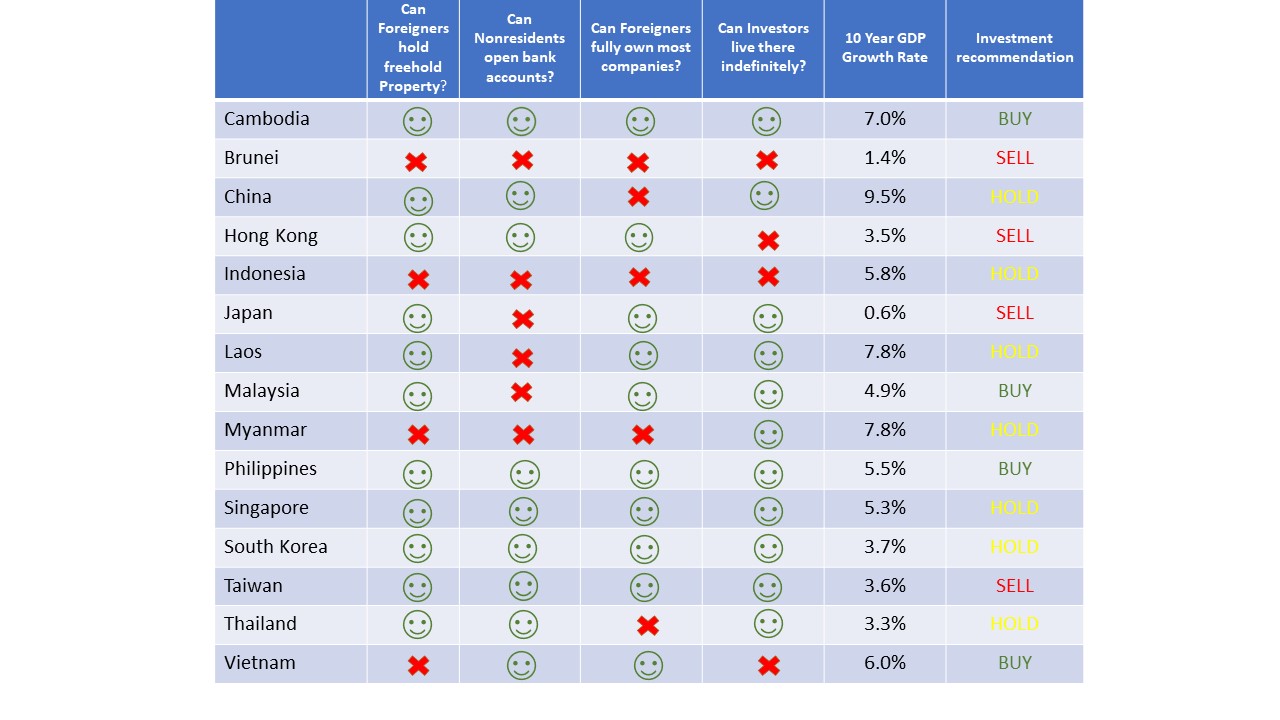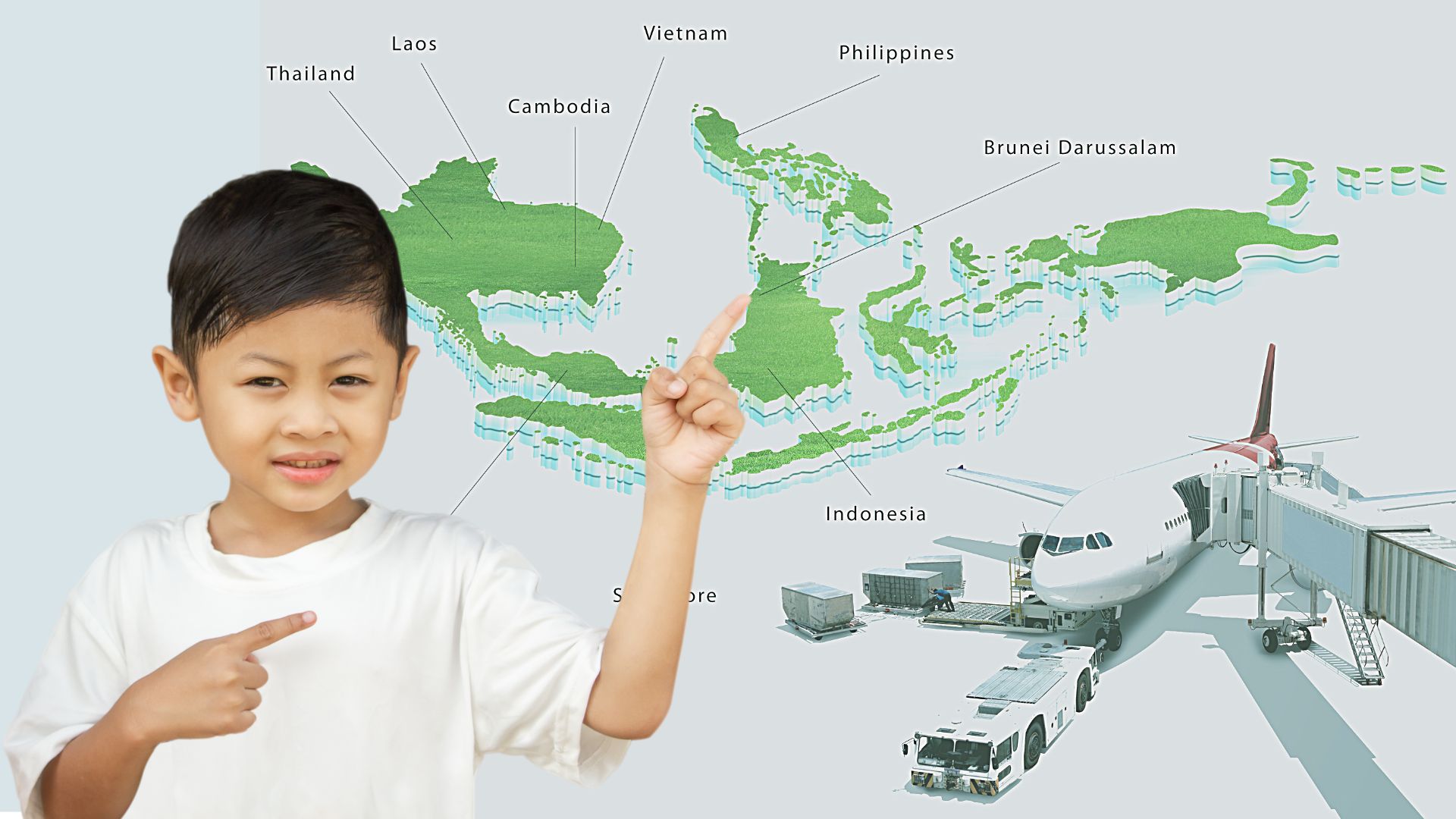Understanding ASEAN : Some things you need to know before investing
China remains the Goliath of emerging markets, with every fluctuation in its GDP making headlines around the globe. But since pandemic and the real estate & supply chain troubles, multinationals and investors are increasingly turning their attention to the ten dynamic markets that make up the Association of Southeast Asian Nations (ASEAN). If ASEAN was a country, it would already be the 6th largest economy in the world, with a combined GDP of $3.6 trillion in 2021 (source : IMF), outpacing dramatically the rest of the world on growth per capita since the late 1970s.
On a multi investment criteria analysis - please refer to our blog "Why Cambodia? - , A.I Consulting has elected Cambodia as the best hub to invest private wealth in 2023, in accordance with notes from big 4 players like KPMG or Deloitte, and also with many consulting companies in Asia.
Let’s get back to basics today.

While AI Consulting has covered a lot of opportunities and investments here in Cambodia, I figured it would be helpful to review the entire ASEAN region that makes up this part of the world and give you an introductory, bird’s eye view at each country and what to make of it.
Things are changing fast here in Southeast Asia and as the balance of power shifts from West to East, there is perhaps no greater place to do business in and learn about.
However, Southeast Asia cannot be lumped together and generalized as a single place. There are ten diverse countries that each have their own strengths, weaknesses, and quirks that must be kept in mind. It’s almost needless to say that a comprehensive outline of ten countries cannot be done in a single article – but here are some quick facts about all of the ten members of ASEAN, or the Association of Southeast Asian Nations, which itself consists of all countries in the region. Analysts have been speaking highly of this region for years, and it remains an excellent outpost for expat entrepreneurs as well as investors.
Investing in the ASEAN region
Singapore
The de-facto financial hub of Southeast Asia, Singapore is one of the most capitalistic societies in the world. One out of every six residents of the city-state is a millionaire and its stable banking system, low taxes, and immigration-friendly policies have led investors and entrepreneurs alike to its shores.
With that said, immigration has become harder in the past decade or so. Wealth has brought the ability to be selective and while a multi-millionaire can move to Singapore rather easily, it’s far more difficult for most others.
Investor's must also keep in mind that Singapore is ranked 8th world's most expensive city in 2022 (source Global Property Guide)
Indonesia
Southeast Asia’s largest country, and the world’s fourth most populous with over 240 million inhabitants. The sheer size of the Indonesian market means that there are a huge amount of opportunities – but compared to Cambodia or Philippines, it is still not investor friendly to foreigners, who are not allowed to fully own companies or hold freehold property.
Brunei
Only around 400,000 people live in Brunei, but this oil-rich nation located on the island of Borneo beats out even Singapore by wealth on a per capita basis. Brunei is ruled by a Sultan who is in the process of converting the nation’s legal system to one based on Sharia law. For now foreign investors are not warmly welcome in Brunei.
The Philippines
his country has something that with the exception of India, is unique in Asia – a huge amount of skilled, English speaking workers that are willing to work for cheap. The Philippines has an unusually large services sector for an emerging market, and is ideal for outsourcing and doing business without having to worry about a language barrier.
AI Consulting has a BUY recommendation on Philippines, but we prefer to invest in a dollarized economy like Cambodia than in the Philippine Peso. Unlike Cambodia, we don't see bureaucracy and corruption improvements in Philippines. Those who want to ship products through should be wary – for now.
Laos
This landlocked and fast-growing GDP country is the only one in Southeast Asia that shares borders with five others, giving it many opportunities. A high-speed rail project is already underway that will link the Southern Chinese city of Nanjing with Bangkok while passing through Laos, and the potential for being a transportation hub is enormous.
While quickly changing, Laos is still undeveloped compared to most others in Asia. Superhighways and rail lines are still under construction, and the non-adventurous might consider waiting a while.
Myanmar
Unless North Korea decides to open for business, Myanmar is Southeast Asia’s final frontier. The nation was once one of Asia’s richest but was been ruled by a military junta for several decades since the 1960s. This has changed, and the result is a country of over 60 million people that are optimistic about their newfound freedom but need basic services. The entrepreneurship opportunities would be endless if it weren’t for the extreme difficulty of doing business in Myanmar.
Many investments and foreign business laws are either vague, or haven’t even been implemented yet. The more cautious may want to wait a few more years.
Vietnam
With supply chain trouble, but also wages and factory costs rising in China, a lot of jobs and multinational companies have moved to Vietnam. Companies such as Nike, Samsung, Intel, and more have built multi-billion dollar factories to benefit from Vietnam’s skilled manufacturing workforce.
Inflation has historically been a problem in Vietnam, though.
On the other hand, AI Consulting doesn't think Vietnam is for now a paradise for foreigh private investors. Indeed the foreign investor is facing many challenges : repatriation of benefits, no possibility to hold freehold property, DONG currency risk.
Thailand
The largest car manufacturer in Southeast Asia, the largest rice exporter in the world, and a capital that was more visited than any other city by international tourists in 2013. The Thai economy has some of everything.
Coups are “a thing” in Thailand and while there have been 17 in the past hundred years, the country seems to always bounce back. Free elections are usually held a year or two after one, but underlying political tensions have not gone away.
Many international investors buy stocks and real estate in Thailand, thinking they have successfully diversified abroad. However, these people are missing out on better opportunities right next door in Cambodia.
Don't get us wrong: Thailand is a big country and it's not impossible to make money with stocks or real estate. But its annual GDP growth rate is one of the lowest in Southeast Asia, barely above that of the US over the past decade.
Thailand's economy is heavily dependent on foreign capital, whether through tourism or FDI. It would be also a wrong judgement to think Thailand will be resilient to a financial crisis from Europe or the Americas.
Malaysia
The Malaysian economy benefits greatly from its multiculturalism. There is a large population of Muslims, Chinese, and Indians – which equates to many rich Middle-Easterners, Chinese, and Indians bringing their money in because of a sense of familiarity. Malaysia’s capital of Kuala Lumpur is the world’s largest Islamic finance center. Tensions still exist, however.
The ethnic Malay majority have implemented policies that favor themselves. Housing discounts, employment preferences, and even Malay-only mutual funds have created resentment among the Indian and Chinese minorities. Southeast Asia’s growth is enormous, and there are possibilities for every kind of investor or entrepreneur.
A stock trader, manufacturer, property flipper, or outsourcer will each find a place to suit their style. Kuala Lumpur is a very westernized place to live, too.
Whichever way you want to do business, it’s better to do it here than in the western world. The developed countries operate with a high amount of efficiency, the emerging markets are an entrepreneur’s playground, and almost everywhere has low taxes. But it’s best to act now. In five years, Cambodia might have attracted Mc Donald too.
Cambodia
A nation that has suffered a lot under the Khmer Rouge, Cambodia is poorer than any other more developed country in Southeast Asia on average – however, this may not be the case for long. Cambodia enjoyed a 10Y GDP growh rate of +7%, and there has not been a single year with negative GDP growth since Pol Pot left power.
As typical with all of Southeast Asia’s less-developed nations, Cambodia suffers from corruption and inefficiency. But this hasn’t stopped plenty of people from making money off the country’s many opportunities, and things are improving day after day on this front.
Please read our blog " Why Cambodia ?" to get full insights about the reasons AI Consulting has elected Cambodia as the best hub to invest in 2023.
Should you wish to get more information from the official Association of South East Asian countries:


